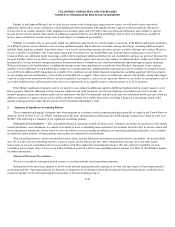Sprint - Nextel 2012 Annual Report Download - page 172
Download and view the complete annual report
Please find page 172 of the 2012 Sprint - Nextel annual report below. You can navigate through the pages in the report by either clicking on the pages listed below, or by using the keyword search tool below to find specific information within the annual report.
Table of Contents
CLEARWIRE CORPORATION AND SUBSIDIARIES
NOTES TO CONSOLIDATED FINANCIAL STATEMENTS
-
(Continued)
deciding how to allocate resources and in assessing performance. Our chief operating decision maker is our Chief Executive Officer.
We operate with a single reportable segment as a provider of 4G wireless broadband services in the United States.
As of December 31, 2012, the dispositions of the assets and liabilities related to our discontinued operations had been completed. See Note 18,
Discontinued Operations, for further discussion. Unless otherwise indicated, information in these notes to consolidated financial statements relates to
continuing operations.
Use of Estimates
— Preparing financial statements in conformity with U.S. GAAP requires management to make complex and subjective
judgments. By their nature, these judgments are subject to an inherent degree of uncertainty. These judgments are based on our historical experience,
terms of existing contracts, observance of trends in the industry, information provided by our subscribers and information available from other outside
sources, as appropriate. Additionally, changes in accounting estimates are reasonably likely to occur from period to period. These factors could have a
material impact on our financial statements, the presentation of our financial condition, changes in financial condition or results of operations.
Significant estimates inherent in the preparation of the accompanying financial statements include: impairment analysis of spectrum licenses with
indefinite lives, including judgments about when an impairment indicator may or may not have occurred and estimates of the fair value of our spectrum
licenses, the recoverability and determination of useful lives for long
-
lived assets, which include property, plant and equipment and other intangible
assets, tax valuation allowances and valuation of derivatives.
Cash and Cash Equivalents
— Cash equivalents consist of money market mutual funds and highly liquid short
-
term investments, with original
maturities of three months or less. Cash equivalents are stated at cost, which approximates market value. Cash and cash equivalents exclude cash that
is contractually restricted for operational purposes. We maintain cash and cash equivalent balances with financial institutions that exceed federally
insured limits. We have not experienced any losses related to these balances, and management believes the credit risk related to these balances to be
minimal.
Restricted Cash
— Restricted cash consists primarily of amounts we have set aside to satisfy certain contractual obligations and is classified as
a current or non
-
current asset based on its designated purpose. The majority of this restricted cash has been designated to satisfy certain lease
obligations.
Investments
— We have an investment portfolio comprised primarily of U.S. Government and Agency marketable debt securities. We classify
marketable debt securities as available
-
for
-
sale investments and these securities are stated at their estimated fair value. Our investments are recorded
as short
-
term investments when the original maturities are greater than three months but remaining maturities are less than one year. Our investments
with maturities of more than one year are recorded as long
-
term investments. Unrealized gains and losses are recorded within accumulated other
comprehensive income (loss). Realized gains and losses are measured and reclassified from accumulated other comprehensive income (loss) on the
basis of the specific identification method.
We account for certain of our investments using the equity method based on our ownership interest and our ability to exercise significant
influence. Accordingly, we record our investment initially at cost and we adjust the carrying amount of the investment to recognize our share of the
earnings or losses of the investee each reporting period. We cease to recognize investee losses when our investment basis is zero. At December 31,
2012 and 2011, our balance in equity method investees was
$0
and
$8.3 million
, respectively, and was recorded in Other assets on the consolidated
balance sheets.
We recognize realized losses when declines in the fair value of our investments below their cost basis are judged to be other
-
than
-
temporary. In
determining whether a decline in fair value is other
-
than
-
temporary, we consider various factors including market price, investment ratings, the
financial condition and near
-
term prospects of the issuer, the length of time and the extent to which the fair value has been less than the cost basis,
and our intent and ability to hold the investment until maturity or for a period of time sufficient to allow for any anticipated recovery in market value. If
it is judged that a decline in fair value is other
-
than
-
temporary, a realized loss equal to the decline is reflected in the consolidated statement of
operations, and a new cost basis in the investment is established.
Fair Value Measurements
— Fair value is the price that would be received to sell an asset or paid to transfer a liability in an orderly transaction
between market participants at the measurement date. In determining fair value, we consider the principal or most advantageous market in which the
asset or liability would transact, and if necessary, consider assumptions that market participants would use when pricing the asset or liability.
F
-
50
























